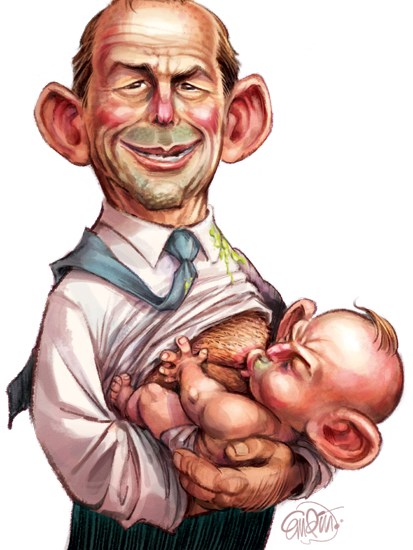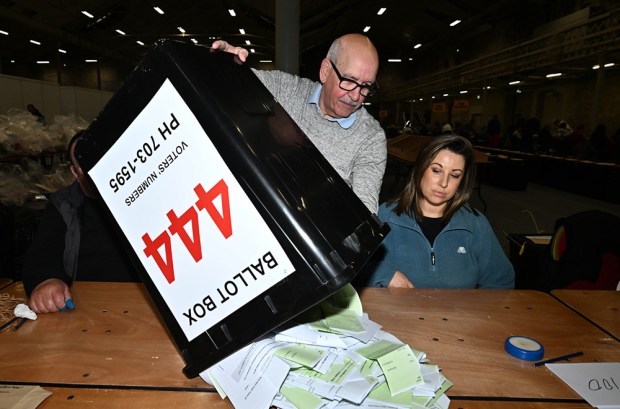Tony Abbott’s paid parental leave scheme is a prescient policy. Efforts to kill it off, both from within his party and from without, are at best short-sighted, at worst envious.
The demographics of Australia are changing quickly, in line with developments across the Western world, where women are attaining higher levels of education, higher salaries and more powerful careers than ever before. In Australia, Roy Morgan recently found that 40% of households have a female breadwinner. And despite remaining inequalities in favour of men, the trend is reversing to favour women. That represents a massive social shift, yet media examination is largely confined to gawping at the domestic chore ratio and sexual dynamics between men and their financially empowered spouses.
The shift is inadequately reflected in government policy – with the exception of the Prime Minister’s friendless, misunderstood and poorly communicated Paid Parental Leave scheme proposal.
Society may change, but biology will not. Women will continue to conceive the babies, carry the babies and bear the babies. Women will still breastfeed the babies. But with women the chief breadwinners, babies will become increasingly unaffordable.
Every policy which offers parents financial or practical support in the process of having and raising children is a social engineering policy, aimed at increasing the numbers of children who will turn into taxpaying adults. But “purchasing children” is about to become considerably more expensive, because women’s time is becoming more valuable.
There are two time horizons in the creation of new taxpayers: child bearing and child rearing. Women who have already borne children, and are naturally most engaged in this debate, will overwhelmingly tell you that their concern is finding and affording care for the children at the rearing stage, in order to return to work. While this is a genuine stumbling block in the short to medium term, and a serious concern for women who need and want to work right now, an exclusive focus on this vote-winner shouldn’t come at the expense of forward-looking policy. Abbott’s PPL is prescient precisely because it presents a solution to the broader social shift.
The bigger picture includes fathers. If 40% of women are the primary breadwinners in their household, 40% of men are earning less than their spouses (this is not reflected in the self-reported figures, though that may say more about our reluctance to recognise and accept change than the actual state of affairs).
The bigger picture must include the interests of the child. Because regardless how modern we all are about work as self-actualisation, the preponderance of studies into child care models find that the child’s interests are best served when mummy stays home for the first three years. Of course there are exceptions that find that daycare is just fine. Data and methodologies are muddy, clouded by ideology and agendas on every side, but one thing is certain: every parent feels their child should have individual attention from a carer who loves them and with whom they can form a long-term bond. The carer to child ratio for children under three is 1:4; one adult for every four wailing kids. One-on-one time is rare.
So men’s time is becoming less valuable, or in more politically correct terms, gender norms are shifting. Meaning people who believe the child’s wellbeing is best served by a parent in the home until the children reach school, may well decide that parent is to be the father. Abbott’s Paid Parental Leave scheme would then allow breadwinning women to perform their biological role, as well as spend a decent amount of time with their infants in the time in which mothers and babies want it most, and then hand over to stay-at-home daddy, without defaulting on the mortgage. This is a new family unit which both progressives and conservatives could find good.
In an uncharacteristically silly paper, the Centre for Independent Studies earlier this year proposed that rather than a PPL, the government should introduce a HECS-style loan scheme through which parents could borrow the money to have children. Aside from the feasibility of a scheme of this sort, including the potential for default on the loan (do we reclaim the cost of being born from the heirs to their parents’ estate? if we can’t do it for study, good luck here) there is a moral dimension to the debate which the CIS ignores.
University study is a publicly-subsidised expense which becomes a mostly private good. Children (without government subsidy) are a private expense which become a public good. If children do eventually support their parents financially, they do so in addition to supporting everybody else via taxation. Children are of course a private pleasure, as well as a private pain in the arse. People would have children anyway for the former reason; but that pleasure has diminishing returns. Government policy, therefore, aims to encourage more children despite the decrease in marginal happiness associated with each extra sprog. The goal is three per couple to replace the parentals and grow the commonweal. That’s a lot of margin.
The perfectly justifiable question of whether there’s room in the budget for what seems an extravagant outlay should come down to whether we can afford to do without. Not because children are an unforeseeable cost but because the costs are so foreseeable and the begetting of children so avoidable. Equal opportunity and meritocratic promotion requires that women be free to take on the roles they have educated themselves for; family values dictate a preference for large families and home-based care. Only when we have set aside envy, self-interest, communist and individualist utopias alike, can we clearly see that this is a policy that will serve everybody’s interests in the society we are becoming.
Got something to add? Join the discussion and comment below.
Get 10 issues for just $10
Subscribe to The Spectator Australia today for the next 10 magazine issues, plus full online access, for just $10.
You might disagree with half of it, but you’ll enjoy reading all of it. Try your first month for free, then just $2 a week for the remainder of your first year.














Comments
Don't miss out
Join the conversation with other Spectator Australia readers. Subscribe to leave a comment.
SUBSCRIBEAlready a subscriber? Log in